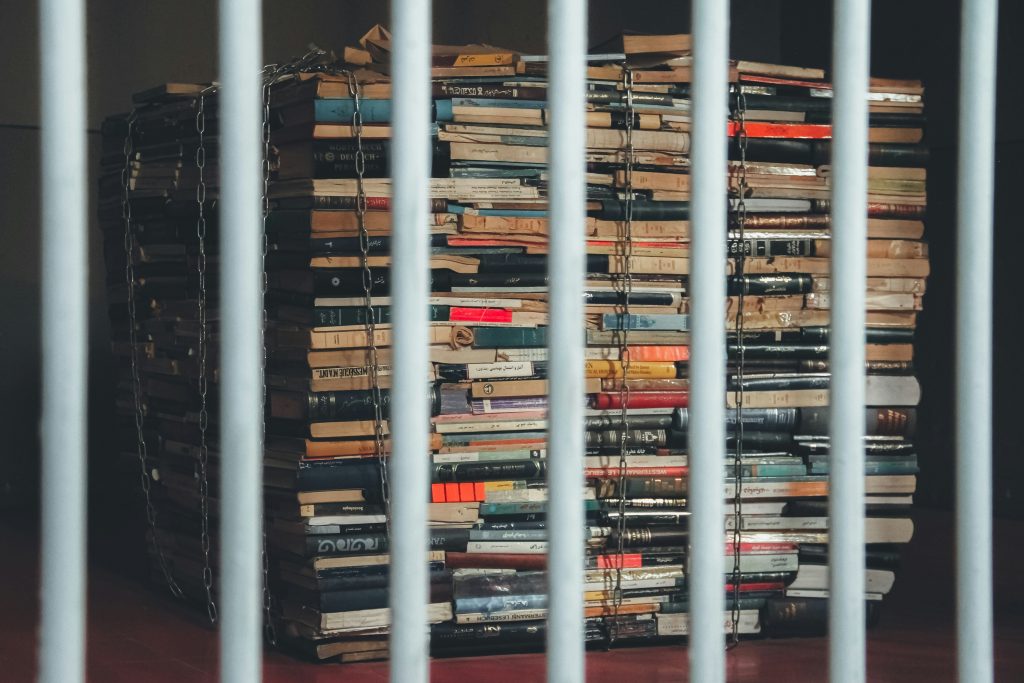By: Danielle Reeves, Staff Writer

While access to books is growing in accessibility for the public, prisons continue to ban books, restricting access to the content of their choosing. Some book bans secure the safety of the prison and the inmates, while others are banned for unknown reasons.1 Across the country, more than 54,000 books are banned in prisons.2
Prison libraries are often underfunded and understocked.3 Many prisons are even opting out of physical copies of books due to the availability of tablets.4 Despite their lack of resources, prisons review material entering the facility through the mail and continue to prevent certain books from being accepted even if sent by friends, family or others.5 Some prisons even have content-neutral bans which restrict prisons to only allow books from specific vendors.6
Prisons across the U.S. have banned books from Just Mercy by Bryan Stevenson to Game of Thrones by George R.R. Martin.7 Many states have instituted bans against specific titles or require a review process before accepting a title.8 Book bans often target titles that are deemed “a threat to prison security.”9 However, many state policies on book bans do not require an explanation as to why the book is banned.10
The Marshall Project is a nonprofit news organization that focuses its writing on the U.S. criminal justice system.11 The Marshall Project has a resource cataloging the books banned in prisons in each state that has a specific list.12 For other states, like Pennsylvania, that have a case by case review policy, The Marshall Project describes what that policy entails.13 Additionally, The Marshall Project states federal “policy contains specific criteria for when a book may be rejected, including if it poses a threat to security, good order, or discipline in the institution,” but leaves the specific banning decisions to the states.14 The policy also states that prisons can determine which form of a book is appropriate for inmates to use.15 Hardback books may be considered a threat due to the potential harm they can cause, especially larger volumes.16 Even if a book is a paperback, it may still be considered dangerous based on its content if it involves violence or other similar themes.17
In Pennsylvania, the Department of Corrections policy states that books must be received from the original source and the Incoming Publication Review Committee will review the publication within 10 days of receiving it.18 If a publication is denied, the Department of Corrections provides an appeal process for publications denied.19 An inmate or a publisher can appeal the material being restricted from the facility by submitting a letter to the facility manager detailing the grievance.20 The appeals process allows a prison to determine whether a book is acceptable or not on a case by case basis, however, there is a general consensus on specific books across the state and even during a case-specific review the book may be denied.21 There is also a similar appeal process for a denied appeal that must be sent within 15 days of notice of the denial.22 If the publication is officially denied, the material will be destroyed within 30 days unless the publisher appeals or the inmate submits a cash slip for the cost of shipping it elsewhere.23
Organizations such as the Pittsburgh Prison Book Project, have formed across the country to improve access to books and resource materials in prisons. The nonprofits utilize volunteers, donations, and sponsors for every part of the process in order to send the books.24 Volunteers read letters sent by inmates and match them with books and resource materials, including resources like dictionaries and thesauruses.25 These nonprofit organizations are aware of books not allowed in the prison, but understand that each package is opened and books that are not on restricted lists can be denied.26
The bans do not stop at books. According to Vera Institute, an organization that serves to end mass incarceration says, “Restrictions aren’t limited to book titles. Maps, survival guides, and even specific magazine issues (of Reader’s Digest and Rolling Stone, among others) are prohibited.”27 Book bans in prisons reach farther than is known to the public due to a lack of transparency.28 Prisons are able to ban books for whatever reason or no reason at all because the information is not made public, preventing any accountability.29 Access to literature and education are rights of all, including those incarcerated. Book bans in prisons should be brought to the forefront of discussions about the rights of incarcerated individuals. No one should be without the right to read.
- https://www.prisonpolicy.org/blog/2024/09/16/prison_banned_book_week/ ↩︎
- https://www.themarshallproject.org/2022/12/21/prison-banned-books-new-york-florida-censorship ↩︎
- Id. ↩︎
- https://www.prisonpolicy.org/blog/2024/09/16/prison_banned_book_week/ ↩︎
- Id. ↩︎
- Id. ↩︎
- https://eji.org/news/banning-books-in-prisons/ ↩︎
- Id. ↩︎
- Id. ↩︎
- Id. ↩︎
- https://www.themarshallproject.org/about?via=navright ↩︎
- https://www.documentcloud.org/documents/23606976-federal ↩︎
- Id. ↩︎
- Id. ↩︎
- Id. ↩︎
- https://www.themarshallproject.org/2022/12/21/prison-banned-books-new-york-florida-censorship ↩︎
- Id. ↩︎
- https://www.documentcloud.org/documents/23607001-pennsylvania ↩︎
- Id. ↩︎
- Id. ↩︎
- Id. ↩︎
- Id. ↩︎
- Id. ↩︎
- https://pghprisonbookproject.org/what-we-do ↩︎
- Id. ↩︎
- Id. ↩︎
- https://www.vera.org/news/the-cruel-practice-of-banning-books-behind-bars ↩︎
- Id. ↩︎
- Id. ↩︎